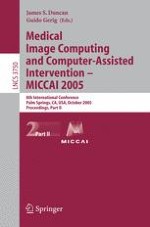2005 | Book
Medical Image Computing and Computer-Assisted Intervention – MICCAI 2005
8th International Conference, Palm Springs, CA, USA, October 26-29, 2005, Proceedings, Part II
Editors: James S. Duncan, Guido Gerig
Publisher: Springer Berlin Heidelberg
Book Series : Lecture Notes in Computer Science
